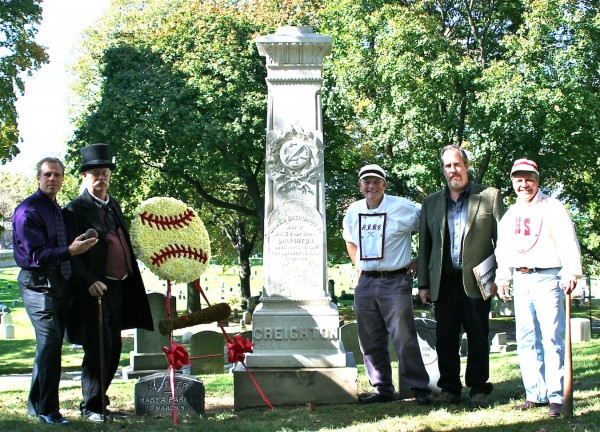Brooklyn was the incubator of baseball in the National Pastime’s infancy–the 1840s, 50s, and 60s. And, the first national baseball hero and legend, James Creighton, is interred at Brooklyn’s Green-Wood Cemetery–where almost 200 baseball pioneers are permanent residents (you may find Glenn Collins’s wonderful article about Green-Wood and baseball, which was published in The New York Times in 2004, here). On October 18, 2012, 150 years to the day after Creighton’s death, baseball historians and fans gathered at his grave to pay homage to one of the giants of baseball.

Creighton was a phenom, both as a pitcher and hitter. He revolutionized pitching by making it competitive; before Creighton came along, the pitcher was duty-bound to throw the ball where the batter wanted it, and the batter was not expected to swing until he got the pitch he wanted. But James Creighton would have none of that: he developed a controversial speedball and a dew drop change-up. Here baseball historian Thomas W. Gilbert, author of Elysian Fields: The Birth of Baseball, Pete Rose, and other books, discusses how James Creighton changed baseball:
On the road in front of Creighton’s monument, Eric Miklich (who maintains the website 19th Century Baseball), demonstrated Creighton’s pitching style:
When, in 1860, Creighton barnstormed with the Brooklyn Excelsiors throughout the northeast and Canada, baseball was on its way to becoming a national game. Teams were organized in the wake of this tour; many were named “The Creightons” in honor of Jim.
And James Creighton was a tremendous hitter. He went through an entire season without making an out. But, sadly, his hitting killed him. On October 14, 1862, James Creighton took a mighty swing at a pitch, heard something snap that he thought might have been his belt breaking, then circled the bases for a home run. But he collapsed as he crossed home plate and died four days later. Here, Tom Gilbert describes his theory on what killed James Creighton:
Later, it was off to Green-Wood’s Historic Chapel. There, research on Creighton, by Major League Baseball’s Historian John Thorn, was read. Thorn concluded that Creighton was “the first professional (paid) player and that by redefining the role of the pitcher as the mortal enemy of the batter he was the man who created the dynamic balance between offense and defense that we enjoy today.” Nineteenth-century-style baseballs and bats were displayed and discussed. And there was talk that James Creighton, for the way he revolutionized baseball, deserves to be in the Baseball Hall of Fame. Here’s hoping!
One final note: James Creighton’s monument at Green-Wood was the scene of the first baseball pilgrimage. In 1866, four years after Creighton’s death, the Washington Nationals and the Brooklyn Excelsiors paid their respects to Creighton as his grave; many of the players were so moved that they clipped blades of grass as souvenirs. That monument originally was topped by a lemon-peel baseball, carved in marble. It long ago disappeared; now The Green-Wood Historic Fund hopes to raise $7750 to replace it. If you would like to contribute to this restoration, please click here.